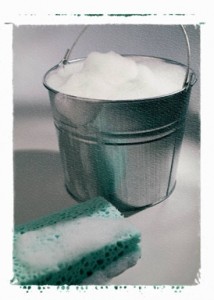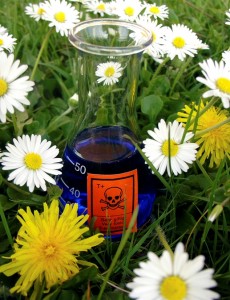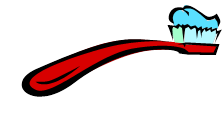Just go grab your toothpaste right now and check the label.
Does Your Toothpaste Have Any of These Ingredients?
- Triclosan (the pesticide)
- Sodium Lauryl Sulfate
- Hydrated Silica
- Tetrasodium Pyrophosphate
- Sodium Flouride (rat poison & insecticide)
- FD&C Blue Dye #1 and #2
- Glycerin
- Alchohol
Even Tom’s of Maine toothpaste contains 4 of these ingredients.1 Are you familiar with Tom’s? Didn’t you think their toothpaste contained safe natural ingredients? But then they don’t say their products are all natural or safe. They say their ingredients are “naturally sourced”.
I guess you can naturally source toxic ingredients.2
Ask yourself the following questions about toothpaste and mouthwash chemicals.
Why Would You Use a Corrosive Chemical in Your Mouth?
Triclosan was developed for use as a surgical scrub.3 It is an antibacterial agent but it is also corrosive.
If Triclosan is safe for humans to use in their mouth and on their body in soaps and creams why is it only classified as a pesticide by the FDA? Once chemicals like triclosan get into your fat cells they are almost impossible to eliminate.4 Quite simply it is a corrosive chemical and shouldn’t go anywhere near your mouth.
Why Put a Poison in our Water Let Alone Use It Directly in Your Mouth?
 If Sodium Flouride is safe why have over 200 medical, scientific and environmental health professionals petitioned US Congress to outlaw flouridation?
If Sodium Flouride is safe why have over 200 medical, scientific and environmental health professionals petitioned US Congress to outlaw flouridation?
And did you know the idea that flouride is good for your teeth was invented by Alcoa so they could dispose of this aluminium mining by-product without costs? Read a flouridation horror story. Yes! The idea that flouride will prevent cavities is a fiction!
According to Dr Ted H Spence, DDS, ND, PhD/DSc, MH flouride causes the following:
- inactivates 62 enzymes
- increases the aging process
- increases the incident of cancer and tumour growth
- disrupts the immune system
- causes genetic damage
- interrupts DNA repair-enzyme activity
- increases arthritis
- is a systemic poison.5
Sodium flouride is a poisonous drug so best to avoid toothpastes, mouthwash and other foods and cosmetics that contain it.
Why Do Manufacturers Think That Blue Toothpaste is More Appealing?
These blue dyes, FD&C Blue Dye #1 and #2, are derived from inorganic and metallic materials and have been shown to cause ADHD, sleeplessness and other symptoms in children.6
If your toothpaste looks pretty it is undoubtedly toxic.
Why Put a Well Known Irritant in Your Mouth? Do You Really Need Sudsy Toothpaste?
 Sodium lauryl sulfate (SLS) is a detergent7 that is highly irritating and dangerous. Just a tiny concentration as low as 0.5% can cause irritation. That is 1/60th of the amount found in some hand soaps. SLS is commonly used in toothpastes, soaps, shampoos, mouthwash, shaving creams and moisturizers.
Sodium lauryl sulfate (SLS) is a detergent7 that is highly irritating and dangerous. Just a tiny concentration as low as 0.5% can cause irritation. That is 1/60th of the amount found in some hand soaps. SLS is commonly used in toothpastes, soaps, shampoos, mouthwash, shaving creams and moisturizers.
It isn’t good for use on the skin let alone in the mouth! Use it on your car engine not on your teeth.
Why Use Sand in Your Mouth?
Yes silica is sand. Yes it whitens your teeth. Is it natural? Yes. Good for your teeth? No.
The use of hydrated silica in toothpaste destroys your tooth enamel, prevents the natural re-calcification of your teeth AND alters the acidic balance of your mouth, gums and tongue. Why is that important? A healthy acidic/alkaline balance will prevent bacteria that causes gum disease.
The use of silica is particularly bad if you already have any form of gum disease. Not to mention silica is often contaminated with the carcinogenic (cancer causing) crystalline silica.
Baking soda as an oral cleanser is a safer alternative for use as a tooth abrasive and whitener…if you really need one.
Would You Prefer a Thick Emulsified Toothpaste or Safe Toothpaste?
Tetrasodium Pyrophosphate is used in a variety of foods. It is used as an emulsifier to make foods thick. It is also used in laundry detergents.
In toothpaste it removes calcium and magnesium from your saliva preventing healthy remineralization of your teeth. It disrupts the acidic / alkaline balance in your mouth and causes oral irritation. Exposure to this chemical causes everything from nausea, diarrhea and eye irritation to respiratory irritation, heart disturbances, liver and kidney damage and blood disorders.
Why on earth would you put this chemical in your mouth?
What Place Does Glycerin and Alchohol have in Toothpaste and Mouthwash?
None!
Glycerin while not necessarily toxic prevents your teeth from naturally re-enamelizing. This is emerging evidence.
The primary active ingredient in most brands of mouthwash is alcohol. It does eliminate harmful bacteria but not for long. Ultimately it has a drying effect creating the very conditions that harmful oral bacteria thrive in…so they grow back quickly and strongly.
There is also a link between alcohol and mouth cancer.
This Article Only Briefly Describes The Toxic Toothpaste Issues
I’ve barely touched on all of the health issues associated with the chemicals discussed on this page and commonly found in toothpastes and other cosmetics and some foods.
The stories, facts and research surrounding the detrimental effects of sodium flouride alone are enough to swear any one off toothpastes and mouthwash.
To get the full details of the health risks associated with these dangerous toxic chemicals download this free report: The Six Hidden Dangers in Toothpaste.
- glycerin, hydrated silica, sodium lauryl sulfate, sodium flouride found on Tom’s of Maine ingredient list at the time of writing and checked again 20 Oct 2012. ↩
- Why you can’t trust the “natural” label. ↩
- The Ten Worst Chemicals in Cosmetics and Personal Care Products ↩
- Triclosan Health Report ↩
- The Flouride Controversy ↩
- Rowe KS, ROWE KJ, Department of Pediatrics, University of Melbourne, Royal Children’s Hospital, Victoria Australia. J. Pediatr, 1994 Nov;125(5 Pt 1):691-8) ↩
- Dangerous Beauty ↩




